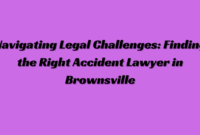Tucson’s Legal Advocates: Navigating the Aftermath of Accidents with Expert Accident Attorneys Accidents are an unfortunate reality of life, […]
oilfield accident lawyers
The Role of Accident Lawyers in Greensboro, NC: Advocates for Justice
The Role of Accident Lawyers in Greensboro, NC: Advocates for Justice Introduction Greensboro, North Carolina, a bustling city with […]
Navigating Legal Challenges: Finding the Right Accident Lawyer in Brownsville
Navigating Legal Challenges: Finding the Right Accident Lawyer in Brownsville Introduction In the bustling city of Brownsville, accidents can […]
Seeking Legal Assistance After an Accident: Finding the Right Accident Lawyer Near You
Seeking Legal Assistance After an Accident: Finding the Right Accident Lawyer Near You In the aftermath of a traumatic […]
The Importance of Accident Lawyers in Las Vegas, NV: Your Legal Allies
The Importance of Accident Lawyers in Las Vegas, NV: Your Legal Allies Las Vegas, NV, renowned for its vibrant […]
Navigating Legal Avenues: Understanding the Role of Accident Lawyers in Fort Lauderdale
Navigating Legal Avenues: Understanding the Role of Accident Lawyers in Fort Lauderdale Introduction:Accidents can happen when least expected, and […]
The Crucial Role of Auto Accident Lawyers: Navigating the Legal Landscape
The Crucial Role of Auto Accident Lawyers: Navigating the Legal Landscape In the fast-paced world of today, auto accidents […]
The Role of an Accident Lawyer in Gilbert: A Comprehensive Guide
The Role of an Accident Lawyer in Gilbert: A Comprehensive Guide Introduction:Accidents can happen to anyone at any time, leading […]
Understanding the Role of Accident Lawyers in Dallas, Texas: Navigating Legal Challenges with Expert Guidance
Understanding the Role of Accident Lawyers in Dallas, Texas: Navigating Legal Challenges with Expert Guidance Introduction In the bustling […]
The Importance of Hiring an Accident Lawyer in San Jose: Navigating Legal Challenges After an Incident
The Importance of Hiring an Accident Lawyer in San Jose: Navigating Legal Challenges After an Incident Accidents can happen […]









